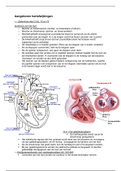Summary
Summary Psychology 314 - Abnormal Psychology
- Course
- Institution
- Book
This 101 page document of study notes covers an in-depth summary of the texbook chapters 1, 2, 3, 5, 7, 8, 10, 11, 12 and 13. I finished this module with a distinction and used these notes from the textbook to study. They cover list the relevant psychological disorders with DSM-5 criteria in a way ...
[Show more]












